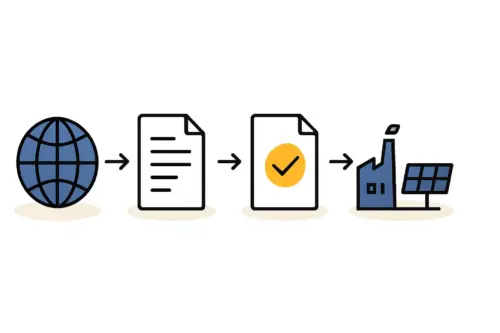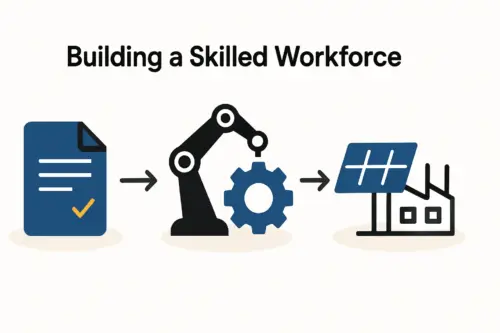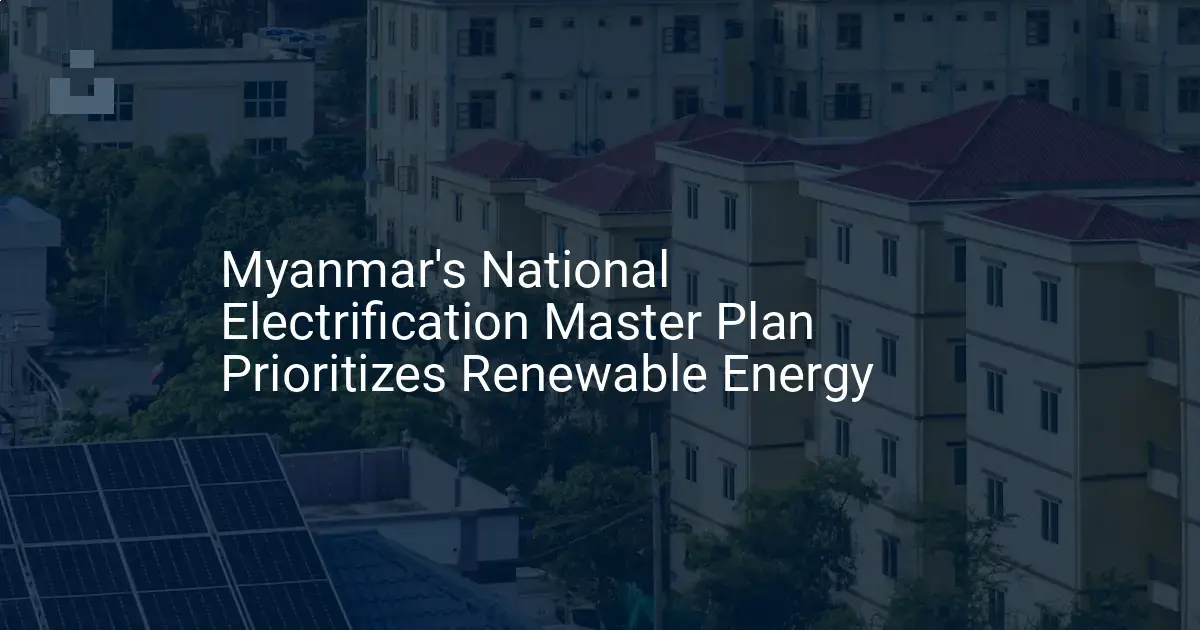Imagine this: your state-of-the-art solar module laminator, a critical component of your new factory, has finally arrived at the port. Production schedules are set, and your team is ready. However, the shipment is held indefinitely by customs due to a minor discrepancy in the documentation. Days turn into weeks, storage fees accumulate, and the entire project timeline is jeopardized.
This scenario isn’t just a hypothetical risk; it’s a common reality for entrepreneurs entering new industrial sectors in markets like Myanmar. For those venturing into solar module manufacturing, the focus is often on technology and the business plan. Yet, the complex journey of getting heavy, sensitive machinery from a global supplier to the factory floor is one of the most critical and underestimated phases.
This article breaks down the key logistical challenges in Myanmar—covering port operations, customs clearance, and inland transport—and outlines a strategic approach to ensure a smooth import process.
Understanding Myanmar’s Unique Logistical Landscape
Myanmar presents a unique mix of opportunities and challenges. While its potential for solar energy generation is significant, its logistical framework requires careful navigation. The current economic and regulatory environment calls for greater due diligence. Import regulations can change, and bureaucratic processes often involve multiple layers of approval, which makes meticulous planning essential.
An investor’s success is determined not by purchasing the best equipment, but by the ability to get it installed and operational. This begins with mastering the supply chain from the moment the machinery leaves its country of origin.
Port of Entry: The First Critical Milestone
Your equipment’s first physical point of entry will be one of Myanmar’s main ports, typically either the Port of Yangon or the facilities within the Thilawa Special Economic Zone (SEZ).
The Port of Yangon is the country’s traditional maritime hub. However, its location on the Yangon River can lead to vessel size restrictions and potential congestion. The Thilawa SEZ, located further south of Yangon, offers more modern infrastructure, deeper sea access, and often more streamlined processes, making it an attractive option for large industrial imports.
The choice between them will depend heavily on your factory’s final location and the road infrastructure connecting it to the port.

Common challenges at this stage include:
Ready to make big Profits?
The solar Industry is Booming
WE HELP NEWCOMERS to the solar industry start their own solar module production line. Customers can make BIG PROFITS by selling modules and finding investors, without wasting money and time on things they don't need!
- Container Handling Delays: Unloading and moving oversized or heavy crates requires specialized equipment that may not always be readily available.
- Demurrage and Detention Fees: These are charges levied by shipping lines and port authorities when containers are not cleared and moved out within a specified free-time period. Inexperienced importers can quickly accumulate thousands of dollars in these fees.
- Coordination: Effective communication between the shipping line, the port operator, and your local logistics agent is essential to prevent costly misunderstandings.
The Customs Clearance Maze: From Paperwork to Release
Once your shipment is offloaded, it enters the customs clearance process. While Myanmar uses the Myanmar Automated Cargo Clearance System (MACCS) to digitize declarations, manual verification and bureaucratic oversight remain a significant part of the procedure. A minor error in paperwork can halt the entire process.
Essential documents for customs clearance typically include:
- Bill of Lading
- Commercial Invoice
- Detailed Packing List
- Import License (often required for capital goods)
- Certificate of Origin
Correctly classifying your solar panel manufacturing machines with the right Harmonized System (HS) codes is crucial. An incorrect code can lead to tariff disputes, penalties, and extensive delays as officials re-evaluate the shipment.
Experience from J.v.G. turnkey projects in Southeast Asia shows that partnering with a seasoned customs broker who understands the specific classifications for photovoltaic equipment is non-negotiable. A robust solar module manufacturing business plan should always include a contingency budget for customs-related fees and potential delays.
The Final Mile: Challenges in Inland Transportation
Successfully clearing customs is a major victory, but the journey isn’t over. The final leg of transportation from the port to your factory site—often referred to as ‘the final mile’—can be the most challenging part of the entire logistical chain.
The infrastructure outside of major economic zones can be unpredictable. Heavy machinery requires specialized transport, and the route must be carefully assessed for:
- Road Quality: Some routes may involve narrow, unpaved roads or bridges with insufficient weight-bearing capacity.
- Obstacles: Low-hanging power lines, tight corners in villages, or seasonal obstacles can make passage impossible for oversized cargo.
- Seasonal Risks: The monsoon season, typically from May to October, can cause flooding and landslides, rendering key routes impassable for weeks at a time.
- Equipment Scarcity: Specialized equipment such as low-bed trailers, mobile cranes, and rigging teams are not always available and must be booked far in advance.
Experience from past factory setups shows that conducting a physical route survey is an essential risk mitigation step. This involves a logistics professional driving the exact route from the port to the factory site to measure clearances, assess road conditions, and identify every potential bottleneck before the cargo even arrives in the country.

A Strategic Framework for Successful Importation
While the challenges are significant, they are manageable with a proactive and structured approach. The following framework serves as a reliable guide for investors.
-
Engage a Local Expert Early
A reputable, well-connected local logistics partner or customs broker is your most valuable asset. They understand the official procedures and the unwritten rules, have relationships with port and customs officials, and can anticipate problems before they arise. -
Conduct Thorough Due Diligence
Verify all import regulations, permit requirements, and applicable duties for your specific machinery long before it is shipped. This includes the physical route survey to ensure the final delivery is feasible. -
Prepare Impeccable Documentation
Ensure that every detail on the commercial invoice, packing list, and bill of lading is accurate and consistent across all documents. The value, weight, dimensions, and description of the goods must match exactly. -
Plan the Timeline with Buffers
Avoid basing your project schedule on best-case scenarios. Build in several weeks of buffer time to account for potential delays at the port, during customs clearance, and in inland transportation. This realistic scheduling is a cornerstone of a professionally managed turnkey solar production line project.

Frequently Asked Questions (FAQ)
What is the biggest logistical mistake new investors make in Myanmar?
The most common and costly mistake is underestimating the complexity of inland transportation. Many focus intensely on customs clearance but fail to plan for the ‘final mile,’ leading to machinery being stranded at the port even after it has been cleared.
How long does customs clearance typically take for heavy machinery?
This can vary significantly. In a smooth process with perfect documentation and a good broker, it might take one to two weeks. However, it’s prudent to plan for three to four weeks or more to accommodate potential inspections, queries, or administrative delays.
Is it better to use the Port of Yangon or Thilawa SEZ?
For heavy industrial equipment, Thilawa SEZ is often the preferred choice due to its modern facilities and more efficient operations. However, the final decision should be based on a cost-benefit analysis that includes the distance and road quality from each port to your factory location.
Are there special permits required for solar manufacturing equipment?
Yes, in most cases, an import license issued by the Ministry of Commerce is required for capital goods. Depending on the scale and nature of the investment, additional approvals from the Myanmar Investment Commission (MIC) or other relevant ministries may also be necessary.
Conclusion: From Planning to Production
Successfully importing solar production machinery into Myanmar is a testament to meticulous planning and local expertise, not luck. By anticipating challenges in the ports, preparing flawless documentation for customs, and rigorously planning the final inland delivery, you lay a solid foundation for your manufacturing operations.
A well-executed logistics strategy ensures that your valuable equipment arrives safely and on schedule, allowing you to transition smoothly from the complexities of importation to the business of producing solar modules. This crucial first step sets the pace for a timely and on-budget project launch.





